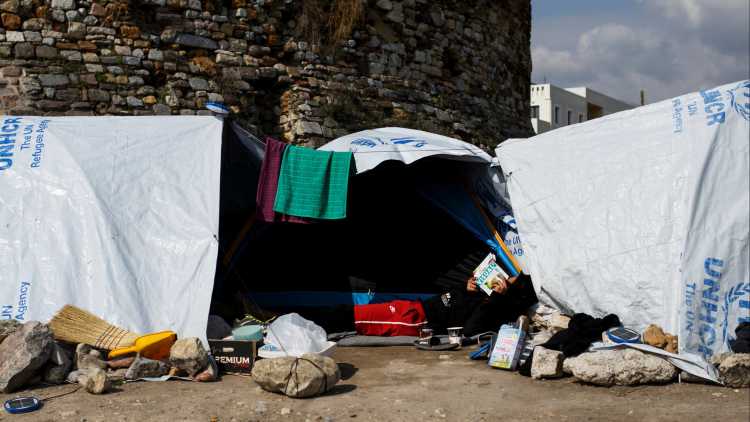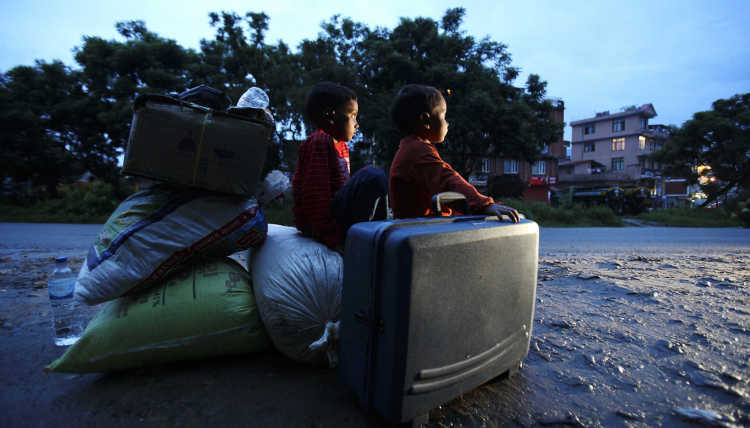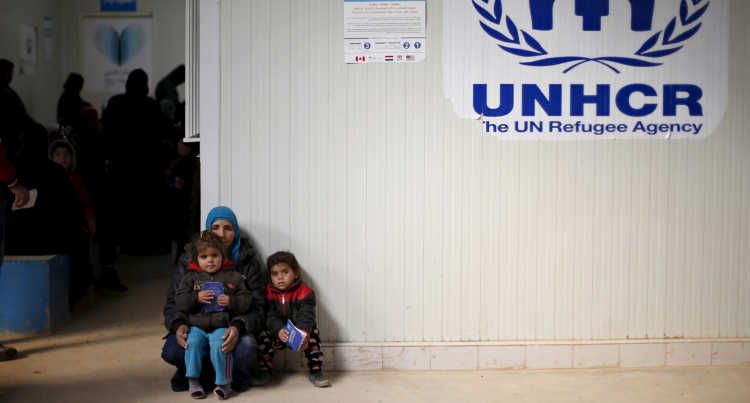- Home
- Publications
- GIGA Focus
- Forced Migration in the Global South: Reorienting the Debate
GIGA Focus Global
Forced Migration in the Global South: Reorienting the Debate
Number 3 | 2018 | ISSN: 1862-3581

As of 2017, 65 million people worldwide had been forcibly displaced by war and political violence. Several millions more have fled because of environmental disasters and socio-economic marginalisation. As there is no immediate end in sight to this steadily increasing global trend, forced migration is one of the central challenges in world politics today – and it is very likely to remain so in the near to medium-term future.
Only a small (albeit increasing) proportion of forced migrants have managed to come to the Global North. The main flows take place within and between Africa, Asia, Latin America, and the Middle East. A focus on South–South displacement thus represents not only a more pluralistic, but also a more accurate picture of global forced-migration trends.
The most visible drivers of forced migration are war and political violence. While Syria stands out in this regard, the country also shows that conflict-induced displacement is often intertwined with forced migration resulting from environmental disasters and the adverse effects of development projects.
Disaster-induced displacement denotes population movements in the wake of global environmental change, including fast-onset events such as floods, storms, or fires, and slow-onset events, such as droughts, land degradation, and sea-level rise. With its low-elevation islands, the Pacific region of Oceania is particularly vulnerable to rising sea levels.
Development-induced displacement results from socio-economic exclusion as a result of large-scale infrastructure projects, mining, deforestation, urbanisation, and biosphere projects. The case of India underlines that many development-induced forced migrants are typically internally displaced.
Policy Implications
As forced migration continues to occur mostly within the Global South, it is necessary to better understand its causes, dynamics, and effects in Africa, Asia, Latin America, and the Middle East in their own right – and not primarily or even exclusively in terms of the implications for the Global North. Also, when drafting policy responses to forced migration, a holistic understanding of the complex interlinkages between conflict-, disaster-, and development-induced drivers and dynamics precludes one-size-fits-all approaches.
The Global Relevance of Forced Migration: Temporal and Spatial Aspects
According to the United Nations High Commissioner on Refugees (UNHCR), the number of people forcibly displaced by violence and political persecution worldwide currently stands at 65 million. An additional average of 22.5 million people have been internally displaced by environmental disasters each year since 2008 (IDMC 2018:2). On top of this, an unknown number of people are being displaced every year by the adverse effects of development projects; the most often cited number for this is 15 million annually, but this is a rough, likely conservative estimate (IDMC 2018:54).
In general, it is safe to say that there has been a clear upward trend of forced migration around the globe over the last quarter of a century. As Figure 1 highlights, a particularly strong rise can be detected over approximately the last decade, starting in the years 2006/07, when the wars in Afghanistan and Iraq experienced massive escalations in levels of violence, forcing many hundreds of thousands of people to flee their homes. Since the years 2012/13, the number of forced migrants around the globe has grown even more, partly as a result of the violent conflicts in the Middle East and in different subregions of Africa. In both time periods, drastic environmental disasters and the detrimental effects of large-scale development projects have further contributed to increasing forced migration. While environmentally induced displacement has received quite a bit of attention in recent years, the scale and relevance of development-induced mobility is only gradually seeping into academic and policy debates, which is reflected in a severe lack of reliable, longitudinal global data. Figure 1 below is based on UNHCR data and shows internal and international, predominantly conflict-induced displacement.

As Figure 1 indicates, for conflict-induced forced migration the largest group comprises internally displaced persons (IDP) – that is, people who had to flee their homes but stayed within their country of origin. This trend also holds when taking into account disaster- and development-induced displacement. Rather often, IDPs find themselves in a dilemma, as the political entity responsible for their protection is also that which caused their displacement in the first place. Often more visible are forced migrants who cross at least one state border. Among them, refugees are the best documented, due at least in part to the special rights afforded to them by the Geneva Convention of 1951. The convention defines who can be called a refugee, a status that comes with certain rights – for instance, the right to protection by the receiving state and the right not to be deported back to where existential threats await (condensed in the principle of non-refoulement). In addition to refugees, asylum seekers, stateless people (people who are deprived of any citizenship rights), and returnees (people who have returned to their country of origin) also belong to the category of migrants crossing state borders.
Looking at the geographical distribution of refugees and IDPs around the globe, it becomes very obvious that forced migration is a phenomenon of the Global South. As Figure 2 illustrates, only a relatively small, albeit slightly increasing proportion of refugees worldwide have managed to come to the Global North, mostly to Germany, France, Italy, Sweden, and the United States. However, the main flows of forced migration take place between and within Africa, Asia, Latin America, and the Middle East. An explicit focus on South–South displacement is thus required to paint an adequate picture of global forced-migration trends.

When differentiating between refugees and IDPs, more detailed, current trends can be detected. As the UNHCR data in Figure 2 shows, the dominant host countries of refugees and persons in refugee-like situations are located in the vicinity of the hotspots of wars and political violence in Africa, Asia, and the Middle East. In sub-Saharan Africa, refugees fleeing the violence in the Democratic Republic of the Congo (DRC), Somalia, and South Sudan temporarily settle in countries such as, respectively, Uganda, Kenya, and Sudan. In Asia, people fleeing the war in Afghanistan often live in Pakistan or Iran. And in the Middle East, people fleeing the violence and political persecution in Syria, Iraq, Libya, and Yemen currently reside in Turkey, Lebanon, Jordan, and Egypt, respectively. Taken together, the large majority of refugees fleeing their countries of origin settle in neighbouring states – and these states are overwhelmingly located in the Global South. This illustrates that the global attention economy, which has focused largely on South–North migration flows, actually misrepresents the spatial characteristics of global forced-migration flows.
Similar to refugees, Figure 2 also highlights that IDPs can almost exclusively be found in the Global South. The highest numbers of IDPs worldwide currently reside in Colombia and Syria, each estimated to be home to more than six million IDPs, some of whom have been displaced multiple times. More than one million IDPs currently live in each Afghanistan, Iraq, Yemen, Ukraine, and many sub-Saharan states, among them the DRC, Nigeria, Somalia, South Sudan, and Sudan.
As stated above, the main causes of forced migration globally continue to be violent conflict and political persecution, including human rights violations. At the same time, there are strong indications that many people have also fled their homes because of the effects of global environmental change, among them natural disasters, and because of the adverse consequences of socio-economic development projects. For this reason, and with no intention of belittling its global importance, we consider an exclusive focus on conflict-induced forced migration to be limiting. In the following, we therefore show that conflict-induced displacement is often strongly interlinked with disaster- and development-induced forced migration – and vice versa.
Conflict-Induced Migration in Syria
Syria represents the most prominent case of conflict-induced forced migration around the globe in the twenty-first century so far. More than half of the Syrian population of circa 21 million has been forcibly displaced since the beginning of the conflict in 2011, when anti-regime demonstrations in the context of the Arab uprisings were met with massive state repression, quickly transforming localised protests into an all-out, internationalised civil war (De Juan and Bank 2015). The UNHCR estimates that approximately 6.5 million Syrians have been internally displaced, among them 2.8 million children. In stark contrast to populist assertions of an imminent end to the fighting in Syria, well over 1.2 million Syrians were forcibly displaced within their own country in the first five months of 2018 alone, many of them for the second or third time. Given the lack of independent reporting from within Syria, we still know far too little about the concrete livelihood situations and survival strategies of the millions of IDPs in the different parts of Syria, as well as of their typical domestic flight routes and migration patterns.
Alongside the many IDPs, the often most visibly suffering Syrians have been the ones who have managed to flee the violence and leave their country of origin since 2011. The UNHCR puts the current number of Syrian refugees at circa 5.7 million (latest figure: 24 May 2018). Most of the Syrians have resided and continue to reside in neighbouring states in the following approximate numbers: 3.6 million in Turkey, 987,000 in Lebanon, 666,000 in Jordan, 250,000 in Iraq, and 129,000 in Egypt. In absolute terms, the millions of Syrians residing in Turkey make the latter the country hosting the most refugees in the world today. In relative terms, Lebanon hosts the most refugees in relation to its populace, as Syrians make up between one-fourth and one-fifth of Lebanon’s total population today. In Jordan, the influx of Syrians since 2011 has occurred in a country that had already received hundreds of thousands of refugees from the region, most notably Palestinians in 1948 and 1967, and Iraqis in the 1980s, early 1990s, and the first decade of the 2000s (Bank 2016).
In fact, Syria itself had been “both a refuge state and a refugee-producing nation” before the beginning of the war in 2011 (Chatty 2017: 25). Syrians have regularly hosted and accommodated massive influxes of forced migrants in their modern history, ranging from inhabitants of the Czarist Russian and Ottoman Empires, including Armenians, Kurds, and Assyrian Christians, to Palestinians post-1948 and post-1967, Lebanese from 1975 to 1989 and in 2006, and Iraqis in the first decade of the new millennium (Chatty 2017:25–27). At the same time, Syrians have for several decades been leaving their home country, some permanently – for instance, to Europe and Latin America – and some temporarily – for instance, to neighbouring Lebanon and other more affluent, resource-rich Arab states as labour migrants.
But Syrians have not only crossed the state border, they have also migrated inside their country of origin on a large scale. Since independence in 1946, there has been a constant development-induced migration from the rural countryside to the cities, both to provincial centres, such as Dar‘a in the South and Deir az-Zor and Raqqa in the East, and to the central economic hubs of Aleppo, Damascus, Homs, and Hama. These demographic shifts have been reinforced and partly guided by deliberate resettlement policies initiated by the authoritarian Ba‘thist regime since the 1960s that have, for instance, led to the emergence of strong Arab-Syrian settlements in Kurdish-dominated regions of the Northeast as well as to the forced dispossession and expulsion of the latter – very much in line with the regime’s Arab-nationalist agenda.
Beyond such development-induced forms of (forced) migration, drastic environmental changes have also had strong effects on migration patterns inside Syria. In the current era, the massive drought period from 2006 to 2009 led hundreds of thousands of Syrians to leave their homes in the Northeast of the country, the so-called “Jazeera” (Arabic for “island”), and to resettle in the agglomerations of and countryside around the larger cities further west, from central Homs to Damascus and southern Dar‘a. While it is still a matter of debate to what extent this particular type of forced migration in Syria was climate/disaster-induced or development-induced, there are strong indications that Syrian state mismanagement was crucial in aggravating the situation for the farmers and peasants in the Northeast, ultimately contributing to their decision to flee (Fröhlich 2016). Also, the drought affected parts of Turkey, Iraq, and Jordan around the same time – in the Iraqi case even more severely – but a comparable internal displacement happened only in Syria. As interviews with drought-affected Syrian families have shown, the IDPs from 2006 to 2009 did not play a central role in the Syrian uprising of 2011 or the ensuing war, thereby dispelling alarmist accounts of an imminent Syrian “climate war” (Selby et al. 2017; Fröhlich 2016).
While disaster-induced factors certainly have not been decisive for the massive forced migration from and within Syria post-2011, they have definitely contributed to reshaping Syrian societal dynamics in the twenty-first century. And while forced migration of Syrians in recent years is, without a doubt, primarily conflict-induced, development-related factors intersecting with the war constellation also need to be taken into account. For a number of Syrians that we interviewed in Jordan and Turkey, the drastically increased cost of living in their home country, the very restricted access to basic services in most of the country, and the rampant corruption on all levels were also crucial factors in their decision to leave their homes. Here, conflict-induced and development-induced triggers of migration go hand in hand. We hypothesise that these dynamics will likely not go away even if the violence were to substantially decline with pro-regime forces militarily gaining the upper hand and conquering even more territory. The reason for this is that any kind of state-centred political and economic reconstruction in Syria will likely profit pro-regime allies, to the detriment of broad swathes of the country’s remaining and potentially returning civil population, conceivably causing even more forced migration in the future.
Disaster-Induced Migration in Oceania
Disaster-induced migration denotes population movements in the wake of global environmental change, including both fast-onset events such as floods, storms, or fires, and slow-onset events such as droughts, land degradation, and sea-level rise. With its low-elevation island nations, the Pacific region is particularly vulnerable to certain environmental changes. All regional states are expected to suffer from the effects of climate change, but the small atoll countries of Kiribati, the Marshall Islands, Tokelau, and Tuvalu are considered particularly vulnerable. While the heavily populated areas in the capitals of Fiji, the Solomon Islands, Papua New Guinea, and Vanuatu are also endangered, the region’s bigger states possess higher-altitude territories to which people can move if necessary. On larger islands in particular, most migration is therefore expected to be temporary and internal, rural-to-urban, and from lower, coastal areas to higher altitudes, especially when environmental events are short-term. Longer-term and potentially irreversible processes such as sea-level rise or the destruction of fresh-water resources through salinisation, however, require long-term solutions, which seem to require international resettlement to at least some extent.
Even under an optimistic climate scenario, the Small Island Developing States (SIDS) will become partly inhabitable; in a pessimistic one, they will vanish completely due to rising sea levels (Barnett and Campbell 2010). Their populations will therefore inevitably experience moderate to total displacement. The SIDS are threatened in three ways: first, in terms of physical availability of land; second, in terms of food production and commercial activities; and third, in terms of health risks and general habitability. In light of these threats, proactive plans have been made, such as the government of Kiribati’s purchasing of land on Vanua Levu Island, Fiji, in order to support agricultural as well as fisheries development, which also includes the option of using the land to resettle Kiribati’s population. Other examples include Vunidogoloa Village in Fiji, the residents of which chose to relocate in early 2014 in order to reduce their vulnerability to the encroaching sea level and floods, and the so far futile attempts of Carteret Islands inhabitants to resettle on Bougainville Island. The most concrete plan is the climate-migration strategy developed by the former government of Kiribati under President Anote Tong (2003–2016). It includes regional migration programmes, plans for community relocation to Fiji, and an education campaign, all under the motto “migrate with dignity” (Klepp and Herbeck 2016) – all aimed to avoid a scenario whereby the people of Kiribati become refugees.
It is important to note here that despite Northern alarmist debates regarding climate change and migration in the Pacific region, many islanders argue against the (mis)use of Oceania as an iconographic “warning symbol” for the effects of climate change and as an experiment site for Northern researchers, journalists, and actors of international cooperation. In the dominant discourse, the island states are depicted as isolated, vulnerable, and in need of development, and as small, poor, and not equipped for economic growth. Islanders criticise this victimisation and the scandalising image of the effects of climate change (Farbotko and Lazrus 2012), pointing out that very little attention has been paid to island inhabitants’ own interpretations of climate change, to their agency, and to their potential strategies for responding to it (Barnett and Campbell 2010). Importantly, local voices have repeatedly insisted that migration is in no way a new practice in Oceania.
Looking back to precolonial times, Epeli Hau’ofa (1993) has described Oceania as a “sea of islands,” where people moved frequently and created social networks, traded and exchanged goods, and found new friends, enemies, or partners. As sea people, islanders were skilfully voyaging extensive spaces for new settlements, as attested in oral tradition and archaeological findings. A similar picture arises from more recent history and, indeed, the present: transnational lifestyles abound, and relationships are kept alive through remittances and social media. Even for those members of the diaspora who cannot afford to go home, their respective heritage islands are still central in their spiritual and social practices. This underlines the fact that historically, environmental migration has always been an important adaptation measure, and that generally, migration is a normal societal process, not an exception. On the contrary: migration with the overall goal of improving or generating livelihoods or of bettering educational and employment opportunities is an integral part of regional (and human) history.
What is more, colonial times saw labour migration and forced relocations. Labour mobility led to a distinct demographic reconfiguration of many Pacific Island societies in the mid-nineteenth century: blackbirding – the kidnapping of Pacific Islanders from their home islands mainly to work on plantations – was a widespread practice. Conservative estimates claim that almost one million Pacific Islanders and a further half million Asians were affected by the Pacific labour trade between the 1860s and 1939. Men were recruited for whaling and for plantation development; many of them never saw their islands again. In terms of forced relocation, Glibertese (the people of today’s Kiribati) were brought to the Solomons and Fiji, Samoans and Solomon Islanders to Fiji. Up to 60,000 islanders were working in the sugar cane fields in Australia until 1901, when they were deported back to their homelands. Another example of forced relocation is the case of Banaba, a part of Kiribati mined for phosphate from 1900 until 1980. Today, the centre of the formerly fertile island is uninhabitable. Its population was displaced to camps in Nauru, Kosrae, and Tarawa by Japanese forces in 1942 and was then relocated to Rabi Island, Fiji, by the colonial government in 1945.
The twentieth century also saw mass migration of Pacific Islanders. New Zealand has accepted large numbers of labour migrants from the Cook Islands and Samoa. The United States took over the territories that were administered by Japan prior to World War II, leading to larger communities of people from the region living in the United States today. Furthermore, the most common migration movements in the region today are from rural areas and outer islands to metropolitan zones; this is mostly for reasons of education and health.
Such activities and movements point to alternative ways of framing the relationship between global warming and human mobility in the Pacific that can help to reorient the debate. For this, the victimising, passive image of the “drowning climate-change migrant” as well as the continuing securitisation of climate change and related human mobility need to be called into question. Instead, “migration-friendly” policies should be developed that focus on human rights and citizens’ dignity in affected states, and which allow for migrants’ self-determination.
Development-Induced Migration in India
Development-induced migrants are those who have to abandon their homes due to, for instance, large-scale infrastructure projects, mining, deforestation, urbanisation, or biosphere projects. Most of them are internally displaced, which means that the entity responsible for their protection is also often the one causing their displacement and that data is difficult to come by, as internal displacement is usually not systematically surveyed. The most often cited number is 15 million displaced globally per year.
As Walicki and Swain (2016:8) write, “the impacts on the lives of people driven from their homes or land by such ventures can be just as severe in terms of scope and duration as those experienced by people displaced by conflict, violence and disasters.” It is important to note that contrary to the commonly declared purpose of development projects, inequality is often exacerbated by pushing predominantly those people from their homes who are already poor or marginalised. The key issue is the process of land acquisition in preparation for development projects, which can be complex, opaque, and protracted. This process entails partial or full dispossession, which may lead to displacement. Sometimes, even rumours of a project can initiate dislocation; more “official” pathways are eviction threats or notifications, cuts in available services, the destruction of homes, or the beginning of construction. Such displacement may also go beyond the expropriated area, as development projects can alter the ecosystem through pollution or resource redistribution and overuse, making the neighbouring areas inhabitable. Displacement due to development projects can thus lead to a downward spiral of marginalisation: it often exacerbates poverty, which then tends to become protracted, as IDPs lose access to adequate housing, land, food, water, health, and education. The results include soaring numbers of homelessness, unemployment, food insecurity, and morbidity.
The regions most affected are commonly underdeveloped but rich in resources, with appealingly low land prices and little political costs associated with repurposing the land, as populations living in such areas are often indigenous, with little access to political representation and economic success to begin with. One example of this kind of displacement is India, which has one of the highest numbers of development-induced IDPs in the world. This is by no means new: development-induced dislocation first became a large-scale trend under British rule, with an estimated 35 million displaced (Dadabhai 1988). The 1894 Land Acquisition Act then made the colonial state the owner of all biodiversity, natural resources, and land without individual titles, thereby laying the ground for further displacements by giving the right to define public purpose and control land use to the state and the state alone. This politics persisted after India gained independence in 1947, as the new nation was trying to kick-start its nascent economy; economic reforms in line with the development paradigms promoted by liberalisation, privatisation, and deregulation further exacerbated this trend throughout the decades leading up to the present. All parts of the country have been affected, and approximately 90 per cent of displacements have been caused by state-run projects (Chakravorty 2016). The government either forcibly expropriates forest, private, or common land for what it deems in the public interest, or it reclassifies forest and common land – for instance, to create national parks. By 2011, India had diverted more than 6.5 million hectares of land to public-interest projects in the fields of agribusiness, infrastructure, resource extraction, and renewable-energy sectors (Walicki and Swain 2016: 16).
Those affected by such decisions have at best received some money to rebuild their lives, but until very recently, there were no regulations obligating the state to resettle or rehabilitate them. As discontent and protests continued over several decades, some practices of compensating, resettling, and rehabilitating affected communities have developed; however, these are unofficial practices rather than official policies, so there is no way to enforce them with due process.
India is planning to continue with major development projects in the fields of agrifuel, infrastructure, resource extraction, and renewable energies, which will require an estimated 11 million hectares of land. An envisaged 100 so-called “smart cities” will require even further land and resettlement, as will large dam projects, which may be needed to provide sufficient and reliable water resources – it seems that development-induced displacement is set to continue.
Nevertheless, development-induced displacement is by no means the only form of displacement in India. War, conflict, and human rights abuses have also produced forced internal migrants. Data is hard to come by, as the country lacks central institutions to coordinate data from federal and state governments. Apart from development-induced displacement, India is also experiencing four other kinds of displacement: first, displacement for political reasons, including secessionist movements (for instance, in Assam and Nagaland); second, displacement due to identity-based autonomy movements (such as in Punjab and Western Assam); third, displacement caused by localised violence (for instance, in caste disputes in Uttar Pradesh or in religiously motivated urban riots in Bombay, Bhagalpur, and Aligarh); and fourth, environmental displacement (for instance, after floods, cyclones, and landslides).
Reorienting the Debate on Forced Migration
It was the “summer of migration” in 2015 that put the issue of forced displacement and immigration centre-stage in political and societal discussions in Europe in general and in Germany in particular. With hundreds of thousands of suffering people crossing the dangerous migration routes across and along the Mediterranean and making their way up north (and thousands dying on the journey), forced migration became an issue in the domestic politics of those countries that were temporarily hosting larger numbers of forced migrants, such as Germany, Greece, Italy, and Sweden, as well as those loudly opposed to in-migration, such as Austria, Denmark, the Netherlands, Poland, and Hungary. In addition to the often alarmist tones, these political and societal debates were characterised by two obvious biases from the perspective of global forced-migration trends: a Northern bias and a conflict bias.
To reorient the debate around a more accurate picture of global forced-migration trends, it is thus important to highlight that forced migration has happened and continues to do so predominantly within the Global South. There is thus a need to understand the causes, dynamics, and effects of forced migration within and between Africa, Asia, Latin America, and the Middle East in their own right – and not primarily or even exclusively in terms of the implications for the Global North. A deeper understanding of South–South flows in the context of both globalisation and North–South relationships is required to avoid reifying the epistemic dominance of Northern perspectives on forced migration, and to engage with the historical experiences and empirical realities in the South, which is a key feature of the GIGA’s approach to scholarship (Narlikar 2016:2).
Furthermore, there is a need to move away from the exclusive focus on violent conflict and political persecution as the only causes of forced migration around the globe. While conflict-induced forced migration continues to be centrally important, as the case of Syria shows, other drivers are gaining in relevance. The effects of global environmental change as well as the adverse effects of development projects are two central factors that need to be taken more thoroughly into consideration – in fact, this is a prerequisite for sustainable and effective migration policies.
Footnotes
References
Barnett, Jon, and John R. Campbell (2010), Climate Change and Small Island States: Power, Knowledge and the South Pacific, London: Earthscan.
Cernea, Michael M., and H. Mathur (2007), Can Compensation Prevent Impoverishment? Reforming Resettlement through Investments, Oxford: Oxford University Press.
Chakravorty, Sanjoy (2016), Land Acquisition in India: The Political-Economy of Changing the Law, in: Area Development and Policy, 1, 1, 48–62.
Chatty, Dawn (2017), The Syrian Humanitarian Disaster: Understanding Perceptions and Aspirations in Jordan, Lebanon and Turkey, in: Global Policy, 8, 25–32.
Dadabhai, N. (1988), Poverty and Un-British Rule in India, New Delhi: Commonwealth Publishers.
De Juan, Alexander, and André Bank (2015), The Ba‘thist Blackout? Selective Goods Provision and Political Violence in the Syrian Civil War, in: Journal of Peace Research, 52, 1, 91–104.
Farbotko, Carol, and Heather Lazrus (2012), The First Climate Refugees? Contesting Global Narratives of Climate Change in Tuvalu, in: Global Environmental Change, 22, 2, 382–390.
Hau’ofa, Epeli (1993), Our Sea of Islands, in: V. Naidu and E. Waddell (eds), A New Oceania: Rediscovering Our Sea of Islands, 2–17, Suva: University of the South Pacific.
IDMC, Internal Displacement Monitoring Center (2018), Global Report on Internal Displacement, www.internal-displacement.org/global-report/grid2018/ (31 May 2018).
IOM, International Organization for Migration (2011), Glossary on Migration. International Organization for Migration, http://publications.iom.int/system/files/pdf/iml25_1.pdf (18 April 2018).
Klepp, Silja, and Johannes Herbeck (2016), The Politics of Environmental Migration and Climate Justice in the Pacific Region, in: Journal of Human Rights and the Environment, 7, 1, 54–73.
Mathur, Hari Mohan (ed.) (2008), India Social Development Report 2008: Development and Displacement, Oxford University Press.
McNamara, Karen E., and Helene Jacot Des Combes (2015), Planning for Community Relocations Due to Climate Change in Fiji, in: International Journal of Disaster Risk Science, 6, 3, 315–319.
Narlikar, Amrita (2016), Because They Matter’: Recognise Diversity—Globalise Research, GIGA Focus Global, 1, www.giga-hamburg.de/en/publication/because-they-matter.
Selby, Jan, Omar S. Dahi, Christiane Fröhlich, and Mike Hulme (2017), Climate Change and the Syrian Civil War Revisited, in: Political Geography, 60, 232–244.
Walicki, Nadine, and Marita Swain (2016), Pushed aside: Displaced for “Development” in India, Internal Displacement Monitoring Center (iDMC) and Norwegian Refugee Council (NRC), www.internal-displacement.org/sites/default/files/publications/documents/201607-ap-india-pushed-aside-en.pdf (9 April 2018).
General Editor GIGA Focus
Editor GIGA Focus Global
Editorial Department GIGA Focus Global
Research Project
Regional Institutes
Research Programmes
How to cite this article
Bank, André, and Christiane Fröhlich (2018), Forced Migration in the Global South: Reorienting the Debate, GIGA Focus Global, 3, Hamburg: German Institute for Global and Area Studies (GIGA), http://nbn-resolving.de/urn:nbn:de:0168-ssoar-57809-3
Imprint
The GIGA Focus is an Open Access publication and can be read on the Internet and downloaded free of charge at www.giga-hamburg.de/en/publications/giga-focus. According to the conditions of the Creative-Commons license Attribution-No Derivative Works 3.0, this publication may be freely duplicated, circulated, and made accessible to the public. The particular conditions include the correct indication of the initial publication as GIGA Focus and no changes in or abbreviation of texts.
The German Institute for Global and Area Studies (GIGA) – Leibniz-Institut für Globale und Regionale Studien in Hamburg publishes the Focus series on Africa, Asia, Latin America, the Middle East and global issues. The GIGA Focus is edited and published by the GIGA. The views and opinions expressed are solely those of the authors and do not necessarily reflect those of the institute. Authors alone are responsible for the content of their articles. GIGA and the authors cannot be held liable for any errors and omissions, or for any consequences arising from the use of the information provided.



















